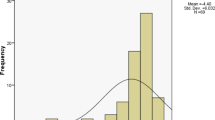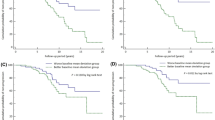Abstract
Objective: To evaluate the medical outcomes of patients treated for primary open angle glaucoma (POAG) or ocular hypertension.
Patients and methods: Sixty-eight ophthalmologists selected at random from a national professional list in France were asked to report on disease progression in consecutive patients who they saw in their clinics and who had either POAG, normal tension glaucoma/ocular hypertension, and who were aged >18 years of age. Data on sociodemographics, general and ocular comorbidities, glaucoma risk factors, visual acuity (VA), optic nerve head (ONH) clinical data, and visual fields were collected. Disease progression was defined as a deterioration of ONH and/or visual field since initial diagnosis. Changes in treatment were also monitored. A treatment change was defined as adding a new drug or changing any of the current treatments. Time to treatment failure was compared using the Wilcoxon test applied to survival curves.
Results: Of 127 patients who were evaluated, 12 developed a disease progression after diagnosis (average follow-up 2.4 years). No statistically significant difference in the known confounding factors of disease progression was found between patients with or without disease progression. At 32 months, 2.6% of the patients with no changes in treatment had a DP, compared with 22.6% with one change in treatment and 46.2% with two or more changes in treatment (p < 0.03). Patients who experienced adverse effects (p < 0.008) and those who said they were unhappy with their treatment (p < 0.03) more often experienced disease progression.
Conclusion: An estimated 9.4% of a representative sample of patients with POAG or ocular hypertension experienced disease progression within 2.5 years of initial diagnosis. Patients with disease progression had more changes in treatment and adverse events; they were also more likely to have complained about being unhappy with their treatment.








Similar content being viewed by others
References
David R, Livingston DG, Lunz MH. Ocular hypertension: a long term follow-up of treated and untreated patients. Br J Ophthalmol 1977; 61: 668–74
Epstein DL, Krug JH, Hertzmark E, et al. A long-term clinical trial of timolol therapy versus no treatment in the management of glaucoma suspects. Ophthalmology 1989; 96: 1460–7
Gaasterland DE, Ederer F, Sullivan EK, et al. The Advanced Glaucoma Intervention Study (AGIS): 4. Comparison of treatment outcomes within race: seven-year results. Ophthalmology 1998; 105: 1146–64
Heijl A, Bengtsson B. Long-term effects of timolol therapy in ocular hypertension: a double-masked, randomized trial. Graefes Arch Clin Exp Ophthalmol 2000; 238: 877–83
Kass MA, Gordon MO, Hoff MR, et al. Topical timolol administration reduces the incidence of glaucomatous damage in ocular hypertensive individuals: a randomized, double masked, long term clinical trial. Arch Ophthalmol 1989; 107: 1590–8
Kass MA, Heuer DK, Higginbotham EJ, et al. for the Ocular Hypertension Treatment Study Group. The Ocular Hypertension Treatment Study: a randomized trial determines that topical ocular hypotensive medication delays or prevents the onset of primary open-angle glaucoma. Arch Ophthalmol 2002; 120: 701–13
Shin DJ, Kolker AE, Kass MA, et al. Long-term epinephrine therapy of ocular hypertension. Arch Ophthalmol 1976; 94: 2059–60
Shulzer M, Drance SM, Douglas GR. A comparison of treated and untreated glaucoma suspects. Ophthalmology 1991; 98: 301–7
Van Veldhuisen PC, Dally LG, Gaasterland DE, et al. The Advanced Glaucoma Intervention Study (AGIS): 9. Comparison of glaucoma outcomes in black and white patients within treatment groups. Am J Ophthalmol 2001; 123: 311–20
Leske MV, Heijl A, Bengtsson B,et al. Reduction of intraocular pressure and glaucoma progression: results from the Early Manifest Glaucoma Trial. Acta Ophthalmol Scand 2002; 120: 1268–79
AGIS Investigators. The Advanced Glaucoma Intervention study (AGIS): 4. Comparison of treatment outcomes within race. Seven-year results. Ophthalmology 1998; 105: 1146–64
Lichter PR, Musch DC, Gillepsie BW, et al. Interim clinical outcome in the Collaborative Initial Treatment Study comparing initial treatment randomized to medications or surgery. Ophthalmology 2001; 108: 1943–53
Hjelmgren J, Berggren F, Andersson D. Health economics guidelines: similarities, differences and some implications. Value Health 2001; 4: 225–50
Strom LB. Pharmacoepidemiology. 2nd ed. Chichester, England: John Wiley, 1994
Lichter PR, Musch DC, Gillespie BW, et al. Interim clinical outcome in the Collaborative Initial Treatment Study comparing initial treatment randomised to medications or surgery. Ophthalmology 2001; 108(11): 1948–53
The AGIS Investigators. The Advanced Glaucoma Intervention Study (AGIS). 4. Comparison of treatment outcomes within race. Seven-year results. Ophthalmology 1998; 105(7): 1146–64
Leske MV, Heijl A, Bengtsson B, et al. Reduction of intraocular pressure and glaucoma progression: results from the Early Manifest Glaucoma Trial. Acta Ophthalmol 2002; 120: 1268–79
Kass MA, Heuer DK, Higginbotham EJ, Johnson CA, et al. for the Ocular Hypertension Treatment Study group. The Ocular Hypertension Treatment Study: a randomised trial determines that topical ocular hypotensive medication delays or prevents the onset of primary open-angle glaucoma. Arch Ophthalmol 2002; 120: 701–13
Calissendorff BM. Costs of medical and surgical treatment of glaucoma. Acta Ophthalmol Scand 2001; 79: 286–8
Jonsson B, Krieglstein G. Primary open-angle glaucoma: differences in international treatment patterns and costs. Oxford: Isis Medical Media, 1999
Kobelt G, Jonsson L, Gerdtham U, et al. Direct costs of glaucoma management following initiation of medical therapy: a simulation model based on an observational study of glaucoma treatment in Germany. Graefes Arch Clin Exp Ophthalmol 1998; 236: 811–21
Kobelt G, Jonsson L. Modeling cost of treatment with new topical treatments for glaucoma: results from France and the United Kingdom. Int J Technol Assess Health Care 1999; 15: 207–19
Kobelt-Nguyen G, Gerdtham UG, Alm A. Costs of treating primary open-angle glaucoma and ocular hypertension: a retrospective, observational two-year chart review of newly diagnosed patients in Sweden and the United States. J Glaucoma 1998; 7: 95–104
Oostenbrink JB, Rutten-van Molken MP, Opdenoordt TS. The treatment of newly diagnosed patients with glaucoma or with ocular hypertension in The Netherlands: an observational study of costs and initial treatment success based on retrospective chart review. Doc Ophthalmol 1999; 98: 285–99
Oostenbrink JB, Rutten-van Molken MP, Sluyter-Opdenoordt TS. Resource use and costs of patients with glaucoma or ocular hypertension: a one-year study based on retrospective chart review in the Netherlands. J Glaucoma 2001; 10: 184–91
Rouland JF, Peigne G, scilern E, et al. An observational, retrospective two-year cost study in primary open-angle glaucoma and ocular hypertension in newly diagnosed patients. J Fr Ophtalmol 2001; 24: 233–43
Association des Epidemiologistes de Langue Francaise. Déontologie et bonnes pratiques en épidémiologie, recommandations de l’Association des Epidémiologistes de Langue Francaise, Saint-Maurice, France, 1998: adelf@st-maurice.inserm. fr
Liste des Prescripteurs. Code TVF. Cegedim, Boulogne-Billancourt, France
Anderson DR, Patella VM. Automated static perimetry, second edition. Mosby, St Louis (MI): 1999
Jonas JB, Budde WM. Is the nasal optic disc sector important for morphometric glaucoma diagnosis? Br J Ophthalmol 2002; 86: 1232–5
Stewart WC, Connor AB, Rogers GM. Correlation of pattern discrimination perimetry to the optic disc and visual field in ocular hypertensive and chronic open-angle glaucoma patients. Int Ophthalmol 1995; 19: 101–7
Chauhan BC, Drance SM, Douglas GR. The use of visual field indices in detecting changes in the visual field in glaucoma. Invest Ophthalmol Vis sci 1990; 31: 512–20
Smith SD, Katz J, Quigley HA. Analysis of progressive change in automated visual fields in glaucoma. Invest Ophthalmol Vis sci 1996; 37: 1419–28
Acknowledgements
This study was supported by an unrestricted grant from Alcon Laboratories SA, Rueil-Malmaison, France. The study was conducted according to the local laws, and was contracted to Cemka, Bourg-la-Reine, France. Alcon Research Ltd employed Gilles Berdeaux through Alcon France. The authors had no financial or other conflicts of interest relating to Alcon Laboratories or directly relevant to the contents of this study.
Author information
Authors and Affiliations
Corresponding author
Rights and permissions
About this article
Cite this article
Denis, P., Lafuma, A. & Berdeaux, G. Medical Outcomes of Glaucoma Therapy from a Nationwide Representative Survey. Clin. Drug Investig. 24, 343–352 (2004). https://doi.org/10.2165/00044011-200424060-00004
Published:
Issue Date:
DOI: https://doi.org/10.2165/00044011-200424060-00004




